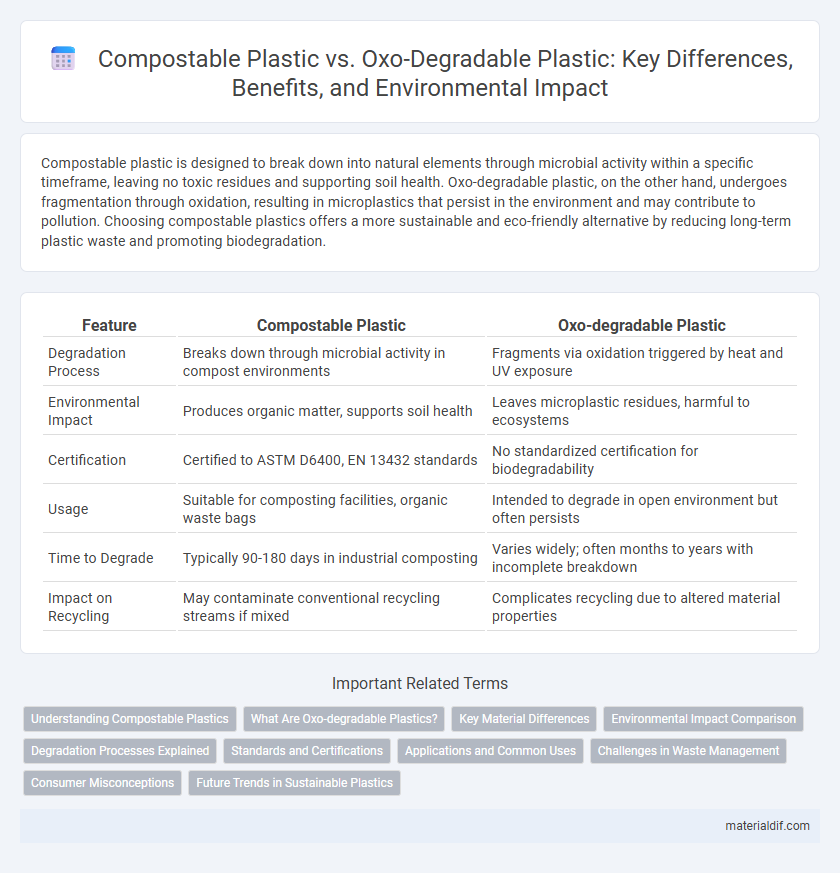Compostable plastic is designed to break down into natural elements through microbial activity within a specific timeframe, leaving no toxic residues and supporting soil health. Oxo-degradable plastic, on the other hand, undergoes fragmentation through oxidation, resulting in microplastics that persist in the environment and may contribute to pollution. Choosing compostable plastics offers a more sustainable and eco-friendly alternative by reducing long-term plastic waste and promoting biodegradation.
Table of Comparison
| Feature | Compostable Plastic | Oxo-degradable Plastic |
|---|---|---|
| Degradation Process | Breaks down through microbial activity in compost environments | Fragments via oxidation triggered by heat and UV exposure |
| Environmental Impact | Produces organic matter, supports soil health | Leaves microplastic residues, harmful to ecosystems |
| Certification | Certified to ASTM D6400, EN 13432 standards | No standardized certification for biodegradability |
| Usage | Suitable for composting facilities, organic waste bags | Intended to degrade in open environment but often persists |
| Time to Degrade | Typically 90-180 days in industrial composting | Varies widely; often months to years with incomplete breakdown |
| Impact on Recycling | May contaminate conventional recycling streams if mixed | Complicates recycling due to altered material properties |
Understanding Compostable Plastics
Compostable plastics are designed to break down into natural elements within a specific timeframe under industrial composting conditions, unlike oxo-degradable plastics that fragment into microplastics without fully biodegrading. These plastics are often made from renewable plant-based materials such as polylactic acid (PLA) or polyhydroxyalkanoates (PHA), ensuring they contribute positively to reducing plastic pollution. Proper disposal in compost facilities is essential for compostable plastics to decompose effectively, preventing environmental harm and supporting circular economy initiatives.
What Are Oxo-degradable Plastics?
Oxo-degradable plastics are conventional plastics embedded with additives that accelerate degradation through oxidation when exposed to heat, light, or oxygen, causing the material to fragment into microplastics rather than fully biodegrading. These plastics do not compost or biodegrade completely, posing environmental risks as the small plastic particles persist in ecosystems. Unlike compostable plastics, which break down into non-toxic components under specific conditions, oxo-degradable plastics contribute to long-term pollution and are often considered misleading in claims about sustainability.
Key Material Differences
Compostable plastics are made from renewable biomass sources such as corn starch or sugarcane, designed to break down into non-toxic components under industrial composting conditions within 90 to 180 days. In contrast, oxo-degradable plastics are traditional petrochemical-based polymers embedded with additives that trigger fragmentation into microplastics through oxidation when exposed to heat and light, but do not fully biodegrade. The key material difference lies in the biodegradability of compostable plastics versus the partial environmental breakdown of oxo-degradable plastics leading to persistent microplastic pollution.
Environmental Impact Comparison
Compostable plastics break down into non-toxic components within a few months under industrial composting conditions, significantly reducing landfill waste and carbon emissions. Oxo-degradable plastics fragment into microplastics, persisting in the environment and posing hazards to marine life and soil health. Selecting compostable plastics promotes sustainable waste management and mitigates long-term pollution compared to the detrimental environmental effects of oxo-degradable alternatives.
Degradation Processes Explained
Compostable plastic breaks down through microbial activity in industrial composting facilities, transforming into water, carbon dioxide, and biomass under controlled temperature and humidity conditions within months. Oxo-degradable plastic undergoes fragmentation triggered by exposure to UV light and oxygen, resulting in microplastics rather than complete biodegradation. The key difference lies in compostable plastic's ability to fully mineralize into non-toxic components, whereas oxo-degradable plastic only partially degrades, contributing to long-term environmental pollution.
Standards and Certifications
Compostable plastics meet strict standards such as ASTM D6400 and EN 13432, ensuring they break down into non-toxic components within industrial composting environments. Oxo-degradable plastics lack equivalent certifications and are not recognized by major environmental agencies due to their fragmentation into microplastics rather than full biodegradation. Certifications from organizations like TUV Austria and the Biodegradable Products Institute (BPI) provide verified evidence of compostability, contrasting with the unregulated status of oxo-degradable materials.
Applications and Common Uses
Compostable plastics are predominantly used in food packaging, agricultural films, and disposable cutlery due to their ability to break down in industrial composting facilities, making them ideal for single-use items with minimal environmental impact. Oxo-degradable plastics find applications in packaging materials, agricultural mulch films, and carrier bags where enhanced durability is needed initially, followed by fragmentation through oxidation under environmental exposure. Both types serve distinct purposes, with compostable plastics prioritized in waste reduction programs and oxo-degradable options used where controlled degradation is necessary for product lifecycle management.
Challenges in Waste Management
Compostable plastics require industrial composting facilities with specific temperature and humidity conditions, which limits their effective degradation in typical waste management systems. Oxo-degradable plastics fragment into microplastics but do not fully biodegrade, causing challenges in recycling streams and potentially harming marine ecosystems. Proper sorting and infrastructure upgrades are essential to address contamination and maximize environmental benefits for both materials.
Consumer Misconceptions
Consumers often confuse compostable plastic and oxo-degradable plastic, assuming both break down harmlessly in the environment; however, compostable plastic is specifically designed to decompose into non-toxic components under industrial composting conditions. Oxo-degradable plastic, on the other hand, fragments into microplastics through oxidation but does not fully biodegrade, posing long-term pollution risks. Misunderstanding these differences leads to improper disposal and hampers effective waste management efforts.
Future Trends in Sustainable Plastics
Compostable plastics, made from renewable biomass sources like cornstarch and sugarcane, are gaining traction due to their ability to break down into non-toxic components within industrial composting facilities, aligning with circular economy principles. Oxo-degradable plastics, which contain additives that accelerate fragmentation under UV light and oxygen exposure, face increasing regulatory restrictions and consumer backlash due to incomplete degradation and microplastic pollution concerns. Future trends in sustainable plastics emphasize the development of fully biodegradable materials with enhanced compostability standards, increased investment in bio-based feedstocks, and innovation in waste management infrastructure to support closed-loop recycling systems.
Compostable Plastic vs Oxo-degradable Plastic Infographic

 materialdif.com
materialdif.com